|
26th
April:
In and around Jim’s garden, Week 5
We’re now into the 5th week of lockdown and my study of the
nature on my doorstep continues. Luckily the weather has been bright
and sunny - ideal conditions for photography. Long may it continue.
Once again I’ve tried to get a collection of good, and
hopefully,
interesting pictures for your perusal. After I mentioned in last
week’s blog that the Blackbird was seldom seen,
he’s been
very visible this week. I think he has a nest in the big tree in my
neighbour’s garden. I’ve got lots of shots of him
calling
from the low branches.
The
group of marauding Magpies have continued their energetic movements,
occasionally resting on the tree at the foot of the garden. They are
members of
the Crow family, and as such are very intelligent, so it is quite
difficult to
get near them as they are up to all my smart moves. I got the shots
below from
inside my open back door.
Of course the House Sparrows are ever-present. They all seem to be
focussing on nest building and of course, eating. I think
I’ve
seen my first fledgling sitting outside the nest in my
neighbour’s
roof. The giveaway sign that it’s a juvenile is the yellow
back
edge of the beak.
The clever Carrion Crows must be taking note of the Sparrows movements
as Crows have a taste for nestlings. Let’s hope
they’re not
too successful, but we must also remember that they too have young to
feed. The ground-feeding Dunnock loves helping to clear up the spillage
from the messy feeders. I’ve yet to see one actually on the
feeder.
| Carrion
Crow |
Dunnock |
 |
 |
Also helping to clear up are the few Wood Pigeons we have seen daily.
They also have a nest in the same big tree as the Blackbirds. I love
their call. It reminds me of when I used to camp in the countryside.
The big Lesser Black-backed Gulls are still on aerial patrol of the
area. I’ve also seen a few Herring Gulls, in transit, rather
than
feeding with the other Gulls. I did also see a Black-headed Gull but I
had no camera at the time.
| Lesser
Black - backed Gull |
Herring Gull |
 |
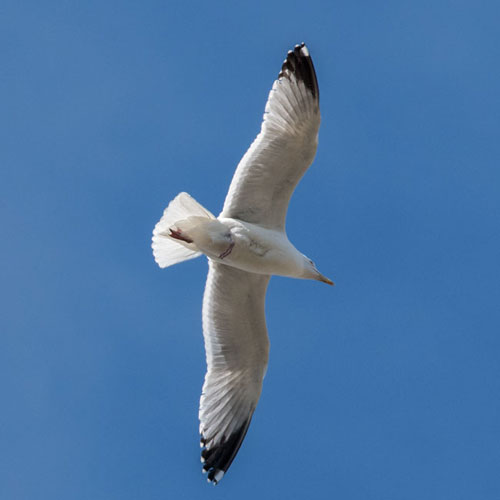 |
I managed a few shots of a Sparrowhawk
scanning our neighbourhood from a height of about 50m. Its spiralling
flightpath took it past us in about 2 minutes, during which time I was
hoping it would strike at the poor Feral Pigeons that were feeding
below my feeders. No such luck.
The Thrift
in my plant tubs have flowered, a fact that was not unknown to the White-tailed
Bumblebee . In the next pot, a seeding Dandelion
yielded a nice picture of a wee orange spider, Parasteatoda
Simulans . I hadn’t the heart to hoe out
the Dandelion (I’ll leave that to my wife).
| White - tailed
Bumblebee |
Spider
- Parasteatoda simulans |
 |
 |
I love the red and amber wallflowers but I have not seen insects showing
an interest in them. The fascinatingly-shaped Rosemary
flowers also seem not to attract insects. However I’ll keep
looking as I have noticed that insect numbers have increased since last
week.
| Wallflower |
Rosemary |
 |
 |
There were no Painted Ladys this week, maybe next week. I did, though
come across a few other interesting insects. The shiny green fly, Eudasyphora
Cyanella
will gradually become more bronzed as it ages. It is often confused
with the Greenbottle. The attractive hoverfly, the Sunfly, is sometimes
called 'The
Footballer' due to its striped thorax. Rhingia
Campestris is another hoverfly, easily recognised by
its long snout. I noticed a female Orange
Tip butterfly ready to receive the attentions of a
passing male. There were no takers in the time I watched her.
| Fly -
Eudasyphora cyanella |
Hoverfly - Sunfly |
 |
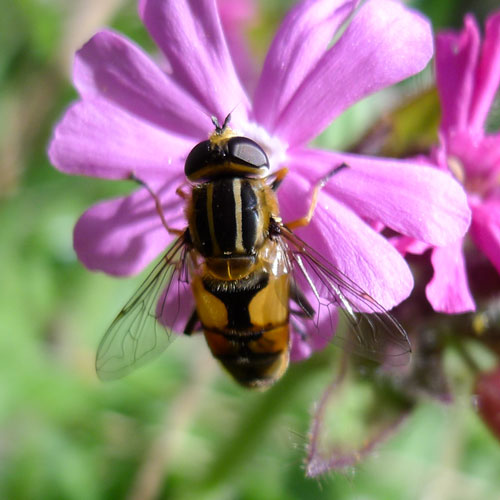 |
| Hoverfly - Rhingia campestris |
Female Orange
Tip Butterfly |
 |
 |
My favourite birds have to be the Blue Tits. Before lockdown we had no
Blue Tits, so it’s great what a few sunflower hearts will do.
I’ve started leaving water by the feeders, in the ornamental
poppy and daffodil. The Tits (and the House Sparrows) have already taken
a few sips - well it’s thirsty work nest building. My final
shot
was of a Jackdaw, taken in amber light, late in the day as the sun was
setting.
| Blue
Tit |
Jackdaw |
 |
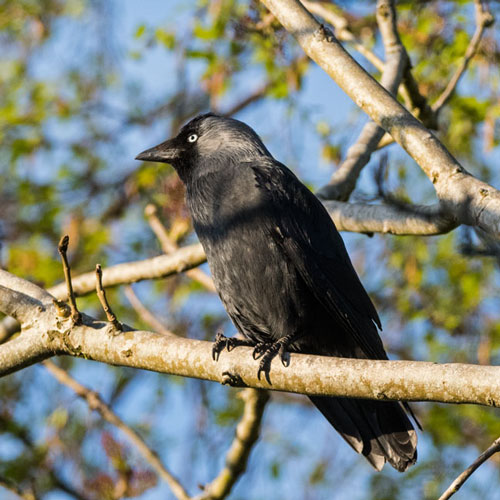 |
Not a bad week for pictures. I’m hoping that next week
I’ll
see a few fledgling Sparrows or Blue Tits. The Carrion Crows are still
about the nest in the tree across the road, so I’m waiting on
some Crow chicks to show. The weather might be a problem though as we
don’t usually have sunny weather in successive weeks. But you
never know.
19th April 2020:
In and around Jim’s garden - Week 4
I’ve approached this week’s blog slightly
differently from
normal; I’ve concentrated on quality over quantity.
It’s
obvious that since I’ve been limited to sightings in and
around
my garden, the blog could get a bit repetitive. So my main focus has
been to gather some fairly good-looking shots of my usual crowd of
“suspects”. Pigeons are so commonly seen that we don’t look closely
enough at
them. They’re actually bonny birds. In the right light, Feral
Pigeons and Woodpigeons show intense iridescent green and violet colours
in their plumage.
| Feral
Pigeon |
Wood
Pigeon |
 |
 |
The Starling too has similar iridescence. Again, it is a very
underrated bird that, on closer inspection, you’ll agree
it’s actually a bit of a looker (and, to be honest, a bit of
a
noisy pest). A cousin of the Starling, with a rather more
mellow
song, is the Blackbird .
It’s neat black plumage is set off by its yellow beak and eye
ring. Quite often, at dusk, I see ours atop a tree singing its heart
out.
| Starling |
Blackbird |
 |
 |
I’ve
spent a lot of time this week photographing a pair of Blue
Tits as they’re a new arrival in my
garden since I’ve put up my feeders.
They’re messy eaters though. Going by the mouthful of moss,
they seem
to be setting up a nest in the tree in my neighbours garden.
They like feeding, usually acrobatically, on the branches of the tree,
but they’ve been regular visitors at the sunflower/peanut/suet
mix
feeder.
My garden hedge is “Sparrow Central”.
I’ve seen about
a dozen at any one time, usually at the fatball feeder, but they make
enough noise for double that number. They quarrel regularly, for why, I
don’t know,
perhaps it’s something to do with
courtship.
There’s been a lot of them gathering nesting material, so
perhaps
they’ve been fighting over nest sites. I spotted a busy cock
Sparrow making repeated journeys into the the roof of a
neighbouring house, undoubtedly making a nest there.
I spent a couple of hours in the back garden taking flight
shots. There was no shortage of birds. Lesser
Black-backed Gulls were continually circling
overhead on the lookout for back
doors opening and scraps of food, usually bread, being chucked.
Likewise the scavenging, cawing Carrion Crows sat high on chimney
stacks waiting for the same opportunities.
| Lesser
Black - backed Gull |
Carion
Crow |
 |
 |
A trio of squabbling Magpies were also very active, swooping between
roofs and trees, occasionally descending into gardens. The Feral
Pigeons were on the rooftops most of the time, only gliding into a
garden when it was threat-free.
| Magpie |
Feral
Pigeon |
 |
 |
I have come across a few early butterflies
this week namely, the Comma, Small Tortoiseshell, Orange Tip and
Peacock.
| Comma Butterfly |
Small
Tortoiseshell Butterfly |
 |
 |
| Male Orange
Tip Butterfly |
Peacock Butterfly |
 |
 |
I’ve noticed Bluebells
in my garden are now coming into
bloom as are Wallflowers .
Great, I now await the insects they
should attract.
| Common Bluebell |
Wallflower |
 |
 |
On one of my daily exercise walks I discovered two species of Anemone -
Wood
Anemone and Balkan
Anemone . Taking care nobody was
about I sneaked a couple of shots for the record.
| Wood Anemone |
Balkan
Anemone |
 |
 |
There’s no “Pictures of the Week” section
as all the
pictures are, arguably, worthy of the title, but for the record, my
favourites are the butterflies. Let’s hope more arrive in the
coming week, maybe a Painted Lady.
12th April 2020:
In and around Jim’s garden - Week 3
While taking breakfast I noticed a wee spider on my kitchen floor. It
turned out to be the Jumping spider, Pseudeuophrys
lanigera .
It is fairly common and widespread in England but gradually spreading
north into Scotland. After consuming my cornflakes and banana I noticed
a cock House Sparrow in the front garden, trying to carry off a large
feather (probably a Gull’s). It gave up in the end.
As I “dug in” for a long Lock-down, I’ve
been assembling an array of Bird
feeders - now up to 5: seed, fatball, sunflower
hearts, nuts and porridge oats.
The main feeder users are the large flock of resident House Sparrows.
They are very noisy and quarrelsome, but I like them nevertheless. A
couple of pairs of Blue Tits like the sunflower hearts and have
apparently nested in the large tree in my neighbour’s garden.
Hopefully they’ll breed there. The Robin (see also,
“Pictures of the Week”, below), more usually a
ground
feeder, has a taste for porridge. It’s nice to see a daily
visit,
around all the feeders, of a Coal Tit. Let’s hope it comes
back
more often and brings a few friends. There’s no sign of the
Greenfinches or Goldfinches this week, but I live in hope.
| Female
House Sparrow |
Blue
Tit |
Robin |
Coal
Tit |
 |
 |
 |
 |
One unexpected visitor to the feeders has been a Mouse .
I think it is a Field Mouse (see also, “Pictures of the
Week”, below), but it could be a House Mouse. I got a few
pictures of it clambering up and down the trellis, trying to reach the
fatball feeder, usually when the Sparrows weren’t there.
Tidying up on the ground most days have been a Dunnock (see also,
“Pictures of the Week”, below) and Woodpigeon, and
of
course the Sparrows. Jackdaws often appear on the tree but I think they
are after bigger food such as dinner leftovers. It’s hard
luck on
them as we usually clear our plates. The other big eaters that are
always on the lookout are the Lesser Black-backed Gulls. I see them on
roofs or circling overhead.
| Dunnock |
Wood
Pigeon |
Jackdaw |
Lesser
Black - backed Gull |
 |
 |
 |
 |
I noticed what looked like a large nest on top of a tall Silver Birch
tree opposite my house. I wondered if it was a Crows’ nest. I
watching it for the best part of an hour, annoyingly against the
sunlight. During that time I heard a calling Crow, but could not see
it, until a large Carrion
Crow flew
in and landed by the nest. The sitting Crow became visible and very
animated, seemingly accepting food from its partner, who then flew over
to the TV aerial of a nearby house. I look forward to watching, and
hopefully, photographing their fledglings in the coming weeks.
On the flower front, I noticed small flowers of Wavy
Bittercress , each with 6 tiny stamen (Hairy
Bittercress has 4). Nearby I also came across some Field
Speedwell
starting to flower in a grassy patch. Near my front garden gate the
strong sunlight caught the petals of a Daffodil but I didn’t
notice any insects near it. Between the stones of my driveway a few
small Common Groundsel plants were seeding - time to get my hoe out!
| Wavy
Bittercress |
Common
Field Speedwell |
Daffodil |
Common
Groundsel |
 |
 |
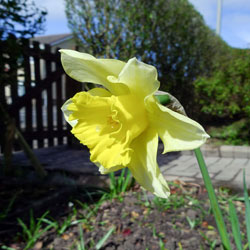 |
 |
On a Dandelion I noticed a small, hairy bee, an Early
Mining Bee. It’s a fairly common bee, widespread in
parks and gardens throughout the UK. Another common insect is the
Hoverfly, Eristalis
Arbustorum,
which was hovering around a leafy shrub of mine. It looks bee-like but
it doesn’t sting. Later I found another bee though, an Early
Bumblebee ,
small as bumblebees go, 2 yellow bands, with a red-tinged tail.
Probably the most numerous of insects in my garden are the ants. I
believe they are a species of Common
Red Ant .
Some years I am forced to take measures to limit their numbers before
they overrun the place. There were a few butterflies about, mainly
Peacock (see, “Pictures of the Week”, below) and a
few
Small Tortoiseshell.
| Early Mining Bee |
Hoverfly
- Eristalis arbustorum |
Early
Bumble Bee |
Common
Red Ant |
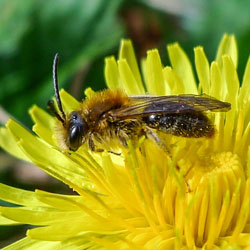 |
 |
 |
 |
Well, the nature in and around my garden is certainly holding my
interest. I’m seeing little stories unfold as more birds are
attracted no my feeders, birds pairing and nesting, promising fledglings
and the promise of more insects and birds appearing as the weeks go by.
I’m particularly looking forward to seeing the Swallows and
Swifts that visit my area each year. Again, you’ll be the
first to
see the pictures!
Pictures of the Week
5th April 2020:
In and around Jim’s garden - Week 2
The Lock-down continues
and I continued nature watching from my back door - working from home,
as it were. For your perusal, I’ve gathered together in this
blog my observations of birds, plants and insects, mainly from the
weekend. The first
morning was rather dull but I managed to capture pictures of some of my
“regulars”
such as a Magpie and Blackbird. I was surprised to see a pair of Blue
Tits skipping across the branches of an Ash tree at the foot of my
garden (see also, “Pictures of the Week”, below). I
didn’t realise they frequented the area. I had only recently
put up 4 feeders - fat ball, seed, nuts and sunflower hearts. However, I
was really surprised to see an almost immediate sighting of a pair of
Coal Tits.
| Magpie |
Female
Blackbird |
Blue
Tit |
Coal
Tit |
 |
 |
 |
 |
I had started my session
by watching from inside the house, from an easy chair at the glass back
doors. I even took some photos through the glass, before progressing to
shooting through the slightly opened double doors. A huge queen Buff-tailed
Bumblebee buzzed past me as I sat in my chair. I
managed a nice shot of it at the window before rescuing it (see,
“Pictures of the Week”, below). I next decided to
sit outside on a stool. The birds didn’t seem to mind. The
House Sparrows were still noisily active in the hedgerow (see also,
“Pictures of the Week”, below). They used the
dividing hedge as a base, able to nip into my garden or my
neighbour’s, or to hide deep in the hedge whenever a threat
appeared. Starlings too were on and in the hedge. Occasionally they
bullied the Sparrows off of the fat ball feeder, but they fled at the
least distraction. The safety positions for the Jackdaws were the
roofs. They grabbed bread in their beaks and flew to the top of the
house for a quick meal.
| Male House
Sparrow |
Female
House Sparrow |
Starling |
Jackdaw |
 |
 |
 |
 |
Throughout the weekend
my neighbours made full use of their back gardens to engage in their
noisiest activities, so scaring the birds away. Undeterred, I moved to
the front of the house and looked to the sky. I was able to snap a few
passing birds such as a Lesser Black-backed Gull, a few Feral Pigeons
and, to my great delight, a Goldfinch. For a time I used my car as a
hide, even scattering sunflower hearts in the front paving hoping to
draw in the small birds. I noticed the call of a Greenfinch coming from
a tree in a neighbours garden. I easily located it in a treetop and,
shooting over my hedge and across a road, I caught an image of the
greenfinch singing its heart out.
| Lesser
Black - backed Gull |
Feral
Pigeon |
Goldfinch |
Greenfinch |
 |
 |
 |
 |
With all the wee busy
birds around, birds of prey were bound to call in from time to time,
and this weekend I did see one pass, a Buzzard
(see, “Pictures of the Week”, below). It was
escorted by a few gulls, but it shrugged them off without a flinch. I
remember photographing a Sparrowhawk
last September. It was sitting on my hedge waiting for a Sparrow to
lose its cool and wing it from the safety of the hedge. Before long it
had its catch (sadly, out of sight).
As I explored the garden
looking for small wildflowers and invertebrates, from the corner of my
eye I caught sight of the flight of a Grey Heron. It was probably
looking for fish in garden ponds. When I turned my attention back to my
original task I found there were no insects, other than a couple of
quickly passing butterflies (Peacock and Small Tortoiseshell). Flowers
worthy of comment were cultivars, Forbes'
Glory of the Snow and Grape
Hyacinth nestling in the small clump of trees.
| Grey
Heron |
Forbes'
Glory Of The Snow |
Grape
Hyacinth |
 |
 |
 |
More prominent in my
garden were the young, bright red leaves of Pieris
that looked at first-sight to be flowers, but in fact they will change
colour to green by the summer’s end. A few elusive bumblebees
were feeding on the white, densely-packed, hanging Pieris flowers.
Eventually the Blue Tits discovered the treasure trove of sunflower
hearts inside my makeshift feeder, as did a Robin, although I think it
was only using it as a perch.
| Pieris
Folliage... |
.... Flowers |
Blue
Tit |
Robin |
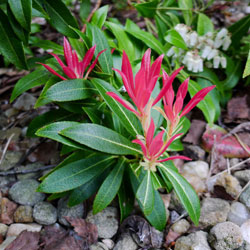 |
 |
 |
 |
Other
“regulars” are the Carrion Crows. They are familiar
sights, usually perched on the highest points such as old TV aerials,
which are also favourite stances for their cousins,
the Jackdaws. My final weekend shots were of a couple of my favourites,
a Woodpigeon and a Magpie, both of which were relatively scarce here
only a few years ago, but now there are well established groups of each.
| Carrion
Crow |
Jackdaw |
 |
 |
| Wood
Pigeon |
Magpie |
 |
 |
I must admit, before the
Lock-down, I hadn’t studied the wonders of nature happening
in my own doorstep. Now that I have been forced to do just that, I can
see what opportunities I’ve missed. It will be interesting
logging the changes that happen over the term of our confinement.
Pictures of the Week
| Blue
Tit |
Queen
Buff - tailed Bumblebee |
 |
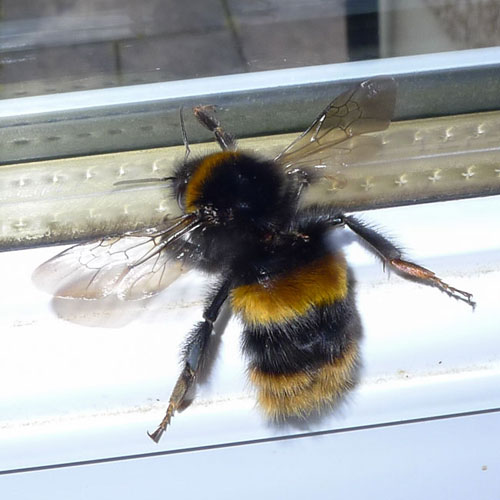 |
| Male House
Sparrow |
Common Buzzard |
 |
 |
Highlights
- April 2020
The pictures below, of
flowers and insects, were taken safely on my daily exercise walks during
the month of April 2020.
BULBOUS PLANTS
| Common Bluebell |
Daffodil |
 |
 |
| Forbes'
Glory of the Snow |
Ramsons |
 |
 |
BUTTERFLIES
| Comma Butterfly |
Female Orange Tip Butterfly |
 |
 |
| Peacock Butterfly |
Small Tortoiseshell Butterfly |
 |
 |
HYMENOPTERA
| Common Carder Bumblebee |
Early Mining Bee |
 |
 |
| Marsham's Nomad Bee |
Early Nomad Bee |
 |
 |
FLIES
| Dark - edged bee - fly |
Fly - Eudasyphora cyanella |
 |
 |
SPEEDWELLS
| Field Speedwell |
Germander Speedwell |
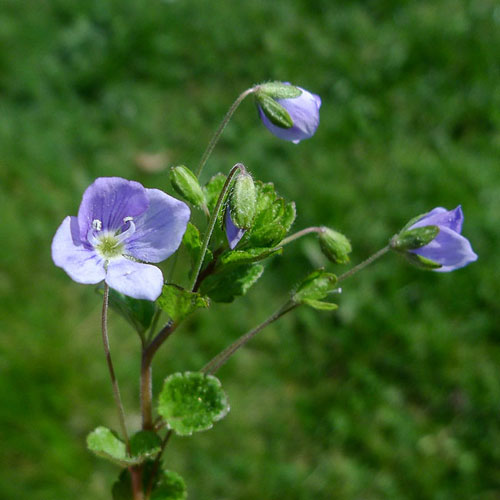 |
 |
| Thyme - leaved Speedwell |
Wood Speedwell |
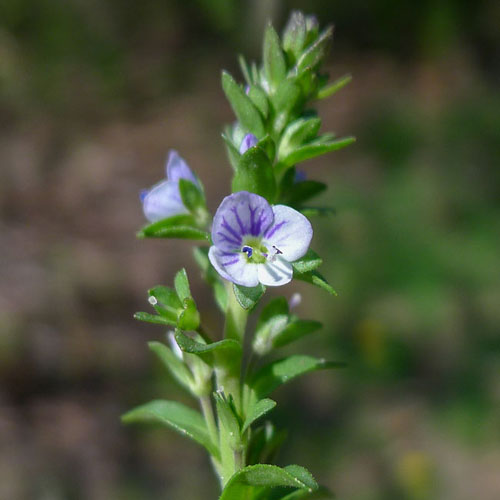 |
 |
FUNGI
| Clustered Brittlestems |
Dryads Saddle |
 |
 |
ANIMAL NAMES
| Cowslips |
Cuckoo Flower |
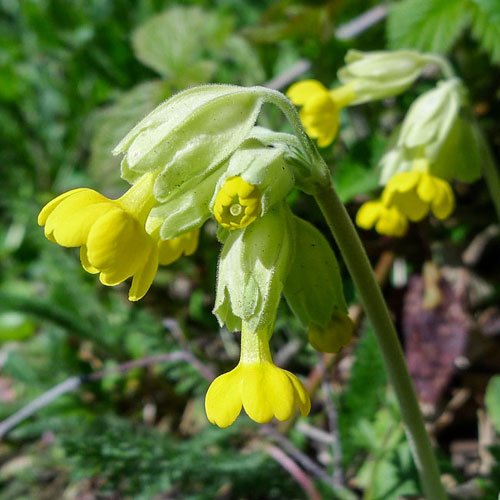 |
 |
| Dog Violet |
Dog's Mercury |
 |
 |
HOVERFLIES
| Eristalis arbustorum |
Rhingia campestris |
 |
 |
| Riponnensia splendens |
Syrphus ribesii / Rhingia campestris |
 |
 |
YELLOW FLOWERS
| Crosswort |
Gorse |
 |
 |
| Lesser Celandine |
Primrose |
 |
 |
| Primula |
Welsh Poppy |
 |
 |
WHITE FLOWERS
| Common Daisy |
Barren Strawberry |
 |
 |
| Garden Strawberry |
Garlic Mustard |
 |
 |
| Greater Stitchwort |
Sweet Cicely |
 |
 |
| Wood Anemone |
Wood Stitchwort |
 |
 |
Back
To Top
|

